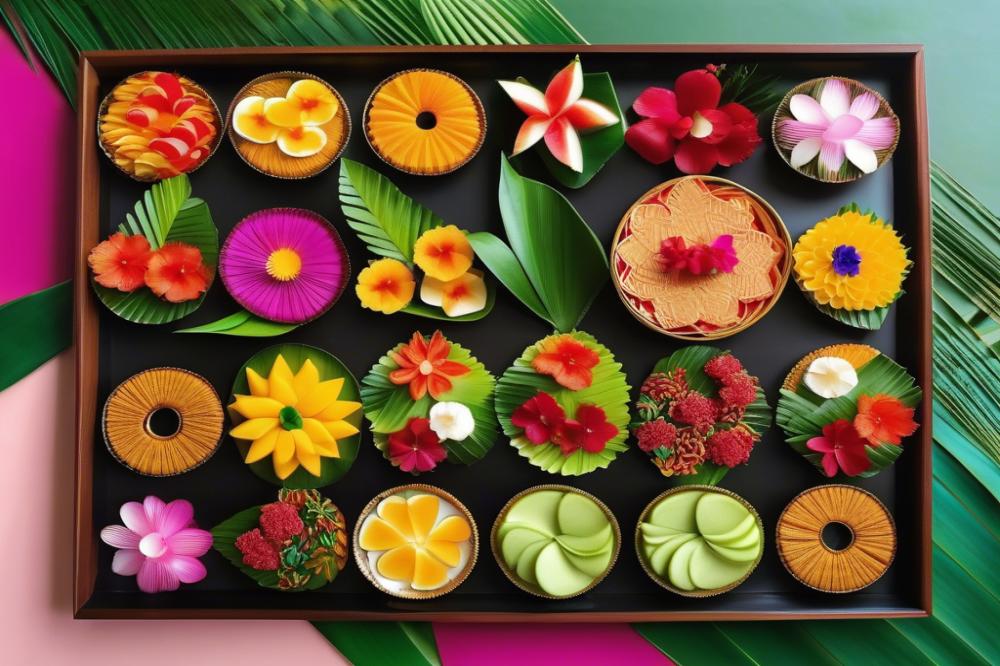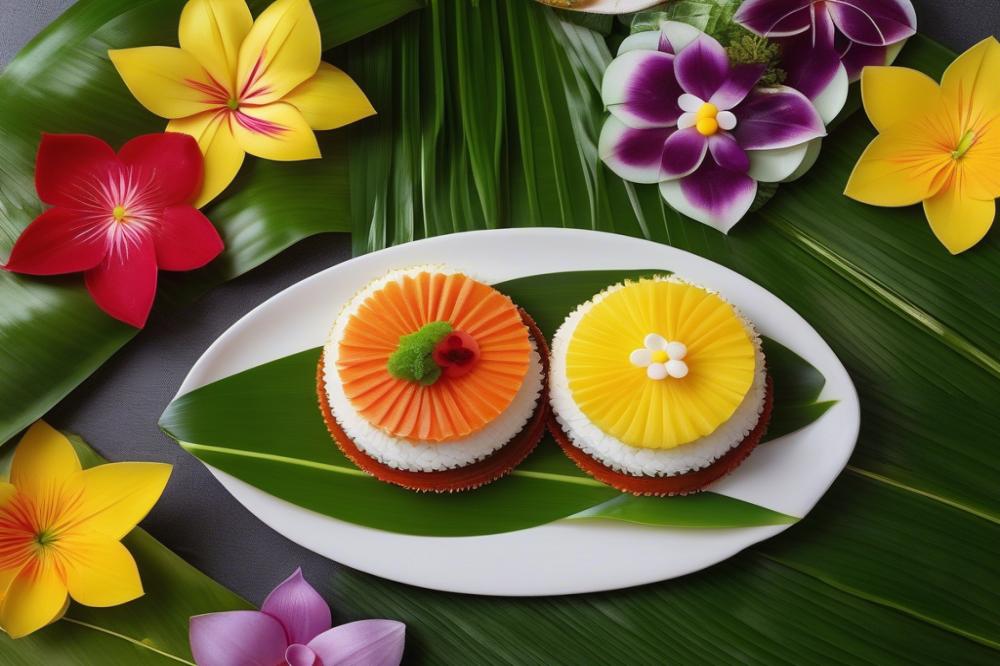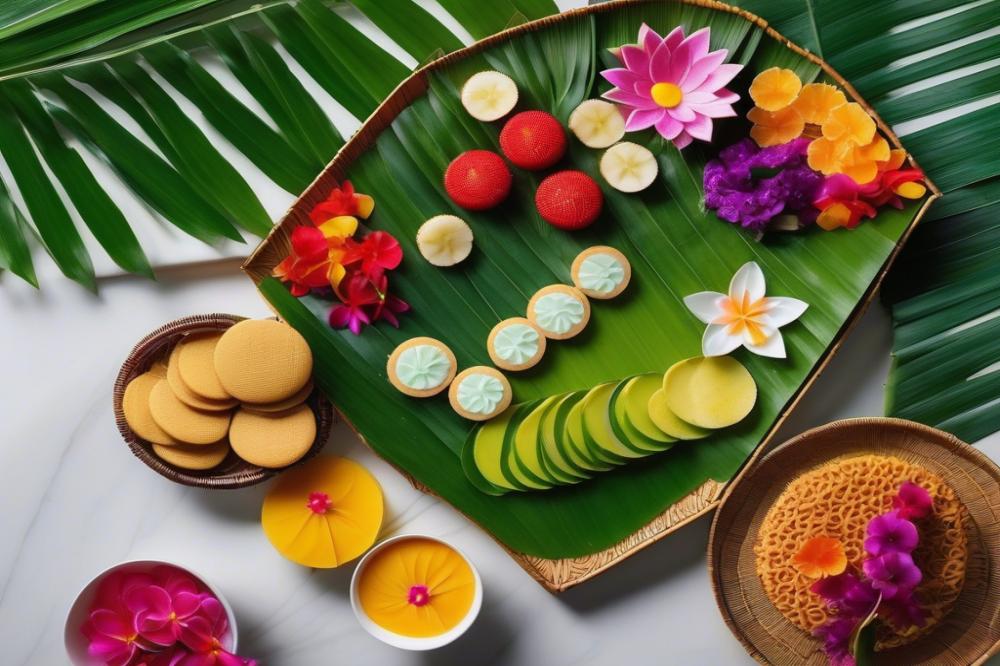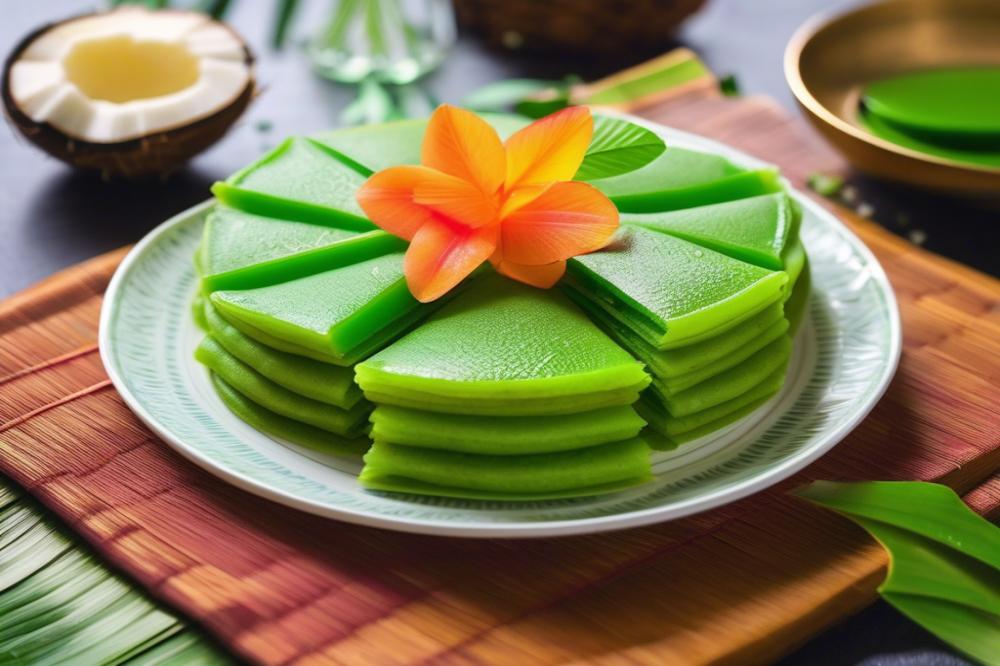Exploring Malaysian desserts
Malaysian desserts offer a vibrant blend of flavors and textures. They are often colorful and celebrate various cultural influences. Among these delightful treats, you will find many enticing options. One of them is a sweet pancake known for its soft texture and rich coconut filling. This dish brings a unique charm to the table.
A Closer Look at Kuih Ketayap

As a beloved traditional recipe, the preparation of these Coconut Pancakes is straightforward. Typically made with pandan crepes, this dessert stands out due to its green hue and aromatic scent. Inside, a mixture of grated coconut and palm sugar reveals itself, forming a satisfying contrast to the delicate crepes. The delightful experience begins with the first bite, as flavors meld together perfectly.
Celebrating Culture Through Food

This dessert holds a special place in festive celebrations and street food culture. People often enjoy it during significant holidays or family gatherings. The presence of such sweets at these events adds joy and warmth to the atmosphere. Many vendors sell these pancakes at bustling markets, making them a staple among street food enthusiasts. It’s an easy recipe that anyone can try at home, bringing a taste of Southeast Asian cuisine into their kitchens. Whether for celebrations or simply a treat, these coconut-filled pancakes never fail to please.
History of Kuih Ketayap

Origins and evolution of Kuih in Malaysian cuisine
Kuih holds a prominent place in Malaysian culinary traditions. This category includes a variety of snacks and desserts cherished by locals. Tracing back to its roots, Kuih has evolved from simple recipes into complex creations that showcase local ingredients. Many sweet pancakes originated from the fusion of indigenous cultures, resulting in diverse flavors and textures. Pantries across Malaysia used pandan leaves, rice flour, and coconut for these delightful treats. Recipes passed down through generations keep the art of making Kuih alive, linking families with their rich heritage.
Cultural significance of Kuih Ketayap in Malaysian festivals
Festivals in Malaysia often feature Kuih as an essential element. During celebrations like Hari Raya and Chinese New Year, these sweet pancakes take center stage. Communities come together to enjoy distinctive flavors while sharing stories and traditions. Both the preparation and consumption of these festive treats create bonds among families and friends. Many believe that Kuih Ketayap symbolizes prosperity and joy, making it a must-have during gatherings. This connection to culture emphasizes the role of food in Malaysian society, blending culinary enjoyment with shared experiences.
Comparison with other traditional Malaysian desserts
Traditional Malaysian desserts vary greatly, yet each boasts its own charm. While Kuih Ketayap is known for its pandan crepes and coconut filling, other desserts offer a different experience. Delightful options like kuih lapis feature layers of rice flour and coconut milk, showcasing vibrant colors. Another favorite, ondeh-ondeh, consists of glutinous rice balls filled with palm sugar and coated in grated coconut. Each dessert holds a special place in hearts, reflecting local availability and creativity. Street food stalls often display these treasures, inviting everyone to partake in the culinary journey of Southeast Asian cuisine.
Ingredients and Cooking Instructions
Ingredients List
- 1 cup all-purpose flour
- 1 cup coconut milk
- 1/2 cup water
- 2 large eggs
- 1 tablespoon sugar
- 1/4 teaspoon salt
- 2-3 pandan leaves (for flavor and color)
For the Coconut Filling:
- 1 cup grated coconut (fresh or desiccated)
- 1/4 cup palm sugar (or brown sugar)
- 1/4 teaspoon salt
Cooking Instructions
Begin with the preparation of the pandan crepes. First, blend the pandan leaves with coconut milk and water until smooth. Strain the mixture to remove any solid bits, creating a colorful and fragrant liquid. In a bowl, mix the flour, sugar, salt, and eggs. Gradually add the pandan-infused liquid. Stir until the batter is well combined and smooth.
Next comes making the coconut filling. Combine grated coconut with palm sugar and salt in a saucepan over low heat. Stir constantly until the sugar dissolves and the mixture is sticky. This filling will give the sweet pancakes their delightful taste.
Assemble the pancakes by heating a non-stick skillet over medium heat. Lightly grease the pan with oil. Pour a small ladle of batter onto the skillet, tilting to spread it evenly into a circle. Cook for about 2-3 minutes until the edges start to lift. Place a spoonful of the coconut filling in the center. Fold the crepe over the filling and cook for another minute. Repeat with the remaining batter and filling.
When serving, arrange the Kuih on a plate. They can be enjoyed warm or at room temperature. These Malaysian desserts are perfect for festive occasions and are often found as a popular street food. Consider serving them with a side of coconut milk for dipping.
Nutritional Information for All Ingredients
The caloric content of this recipe varies based on specific brands and ingredients used. On average, each serving (one pancake) contains approximately:
- Calories: 160-180
- Fats: 7g
- Carbohydrates: 25g
- Protein: 3g
- Fiber: 2g
This easy recipe is rich in nutrients, making it a delightful addition to any meal or snack. Enjoy the taste of Southeast Asian cuisine with these pandan crepes filled with coconut goodness.
Variations of Kuih Ketayap
This delightful Malaysian dessert offers more than one way to enjoy it. Different types of fillings can completely change the experience. Some people opt for Gula Melaka, a rich palm sugar that adds a deep sweetness. Others prefer sweetened condensed milk for a creamy contrast with the coconut filling.
Substituting alternative flours can make this dish suitable for various diets. Gluten-free options, such as rice flour, can replace regular flour. This adaptation makes the sweet pancakes accessible to those with dietary restrictions. For those who follow a vegan lifestyle, simply use plant-based ingredients in the batter and filling. This easy recipe retains the traditional essence while fitting modern needs.
Regional Variations
Throughout Malaysia and Southeast Asia, the Kuih takes on regional characteristics. In some areas, the crepes may be thicker or thinner, depending on local traditions. Flavoring the batter with different herbs or spices can also be seen in various regions. In Thailand or Indonesia, similar Coconut Pancakes exist under different names with local twists.
Festive occasions often inspire unique presentations of this tasty treat. Festivals might feature colorful versions, showcasing vibrant toppings or fillings. Street food vendors sometimes have their own secret recipes, drawing in crowds with enticing aromas. Each variation tells a story of its origin, celebrating the rich tapestry of Southeast Asian cuisine.
Kuih Ketayap in Contemporary Culture
In Malaysia, the sweet pancakes filled with coconut are a cherished part of daily life and festivities. Known for their vibrant green color from pandan leaves, these delicious treats often grace tables during special occasions, like weddings and festivals. Families enjoy them as a snack or dessert, celebrating moments big and small with every delightful bite. The richness of the coconut filling paired with the soft pandan crepes creates a comforting experience that many people treasure.
Street food culture thrives across Malaysia, and Kuih Ketayap is a common find at markets and food stalls. Local vendors whip up these delightful treats fresh throughout the day. You can spot them being prepared in bustling markets, where the aroma of coconut fills the air. Eating these pancakes from a street vendor is part of the charm, connecting people to the heart of traditional shopping districts. Delicious versions can be found in popular spots like the bustling streets of Kuala Lumpur or in vibrant Penang night markets.
Modern interpretations of this Malaysian dessert embrace creativity. Chefs experiment with different fillings, adding ingredients like chocolate or fruits to give a twist to the classic recipe. Some places even serve gourmet versions that elevate the simple sweet pancakes into something extraordinary. This fusion cuisine reflects a blend of traditional roots and contemporary tastes, making the dish appealing to both locals and tourists alike. Whether you stick to the familiar coconut filling or try a new variation, there’s an exciting world of flavors waiting to be discovered.
Final Thoughts on Kuih Ketayap
Reflecting on the importance of this delicious treat, it’s clear that Kuih Ketayap holds a special place in Malaysian cuisine. As a beloved dessert, it brings people together during gatherings and festive seasons. These sweet pancakes have become a symbol of celebration and cultural heritage. Sharing them with family and friends creates lasting memories, making each bite more than just a taste but a connection to tradition.
Trying to make this dish at home can be a delightful experience. With just a few ingredients, the preparation is straightforward and fun. You’ll gain a sense of accomplishment by creating something so cherished. Whether for a festive occasion or just a casual snack, these delightful creations are sure to brighten your day. Don’t hesitate to experiment with the filling, adding a personal touch to this traditional recipe.
Preserving recipes like this one is vital in modern culinary practices. It connects us to the past while allowing future generations to enjoy the flavors of their heritage. By sharing and preparing dishes like this, we keep the culture alive. Each time someone tries their hand at making this Malaysian dessert, they contribute to its legacy. Embrace the experience—step into the kitchen and start crafting these delightful treats. Remember, cooking is as much about joy as it is about following a recipe.



